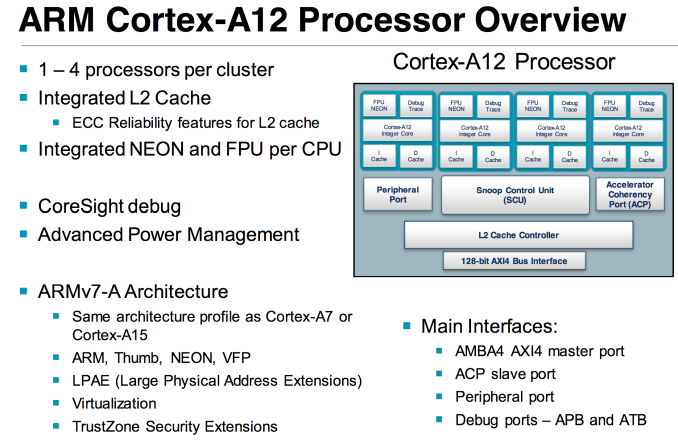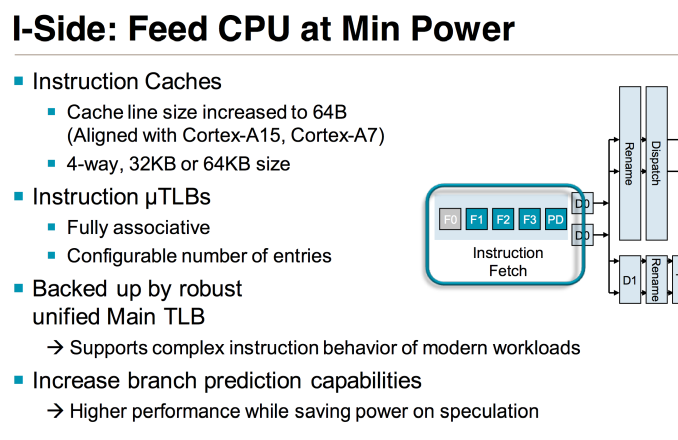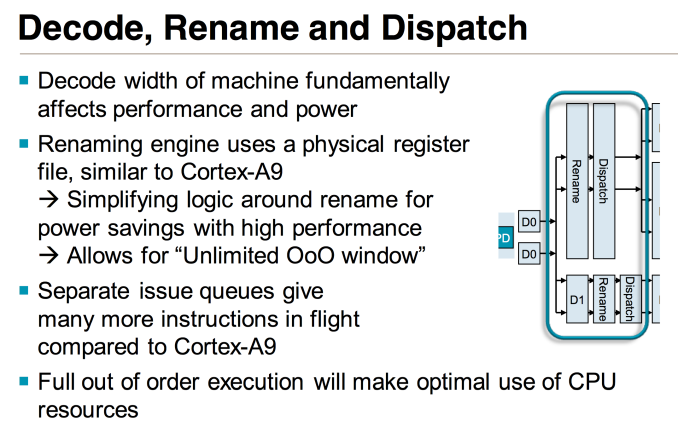The ARM Diaries, Part 2: Understanding the Cortex A12
by Anand Lal Shimpi on July 17, 2013 12:30 PM EST- Posted in
- CPUs
- Arm
- SoCs
- Cortex A12
Introduction to Cortex A12 & The Front End
At a high level ARM’s Cortex A12 is a dual-issue, out-of-order microarchitecture with integrated L2 cache and multi-core capable.
The Cortex A12 team all previously worked on Cortex A9. ARM views the resulting design as not being a derivative of Cortex A9, but clearly inspired by it. At a high level, Cortex A12 features a 10 - 12 stage integer pipeline - a lengthening of Cortex A9’s 8 - 11 stage pipeline. The architecture is still 2-wide out-of-order, but unlike Cortex A9 the new tweener is fully out of order including load/store (within reason) and FP/NEON.
Cortex A12 retains feature and ISA compatibility with ARM’s Cortex A7 and A15, making it the new middle child in the updated microprocessor family. All three parts support 40-bit physical addressing, the same 128-bit AXI4 bus interface and the same 32-bit ARM-v7A instruction set (NEON is standard on Cortex A12). The Cortex A12 is so compatible with A7 and A15 that it’ll eventually be offered in a big.LITTLE configuration with a cluster of Cortex A7 cores (initial versions lack the coherent interface required for big.LITTLE).
In the Cortex A9, ARM had a decoupled L2 cache that required some OS awareness. The Cortex A12 design moves to a fully integrated L2, similar to the A7/A15. The L2 cache operates on its own voltage and frequency planes, although the latter can be in sync with the CPU cores if desired. The L2 cache is shared among up to four cores. Larger core count configurations are supported through replication of quad-core clusters.
The L1 instruction cache is 4-way set associative and configurable in size (32KB or 64KB). The cache line size in Cortex A12 was increased to 64 bytes (from 32B in Cortex A9) to better align with DDR memory controllers as well as the Cortex A7 and A15 designs. Similar to Cortex A9 there’s a fully associative instruction micro TLB and unified main TLB, although I’m not sure if/how the sizes of those two structures have changed.
The branch predictor was significantly improved over Cortex A9. Apparently in the design of the Cortex A12, ARM underestimated its overall performance and ended up speccing it out with too weak of a branch predictor. About three months ago ARM realized its mistake and was left with the difficult situation of either shipping a less efficient design, or quickly finding a suitable branch predictor. The Cortex A12 team went through the company looking for a designed predictor it could use, eventually finding one in the Cortex A53. The A53’s predictor got pulled into the Cortex A12 and with some minor modifications will be what the design ships with. Improved branch prediction obviously improves power efficiency as well as performance.














65 Comments
View All Comments
crypticsaga - Wednesday, July 17, 2013 - link
Is it just me or have the arm architecture reviews become more interesting than the intel or amd ones?WhitneyLand - Wednesday, July 17, 2013 - link
Your tastes are changing. I used to read power supply and case reviews, now I usually don't even peek at the summary. I guess you could say some people are interested in where the action is, and while Intel is making bold moves (I still read Intel articles) there are still many things that we already know from previous reviews. ARM is still novel to us.jeffkibuule - Monday, July 22, 2013 - link
They are constantly evolving. Intel isn't experiencing hyper growth in performance anymore, instead optimizing for power which is far less sexy.lilmoe - Wednesday, July 17, 2013 - link
Cortex A12 is too late to the game. Too frustratingly so.name99 - Wednesday, July 17, 2013 - link
What game is that? ARM is in the business of making money. It will sell hundreds of millions of these to the developing world, and make money on each one.If you want to view low-power CPUs as porn, not a business, you should be spending your time watching Apple (and to a lesser extent, Qualcomm and, maybe one-day Intel) not ARM.
lilmoe - Wednesday, July 17, 2013 - link
I'm strictly speaking business, not porn, thank you. To me, Cortex A12 is addressing the same problem that Krait and Swift cores addressed (specifically in memory bandwidth), where competitors are clearly >2 years ahead by the time of availability. Look how "successful" A15 vendors are (/s) while Qualcomm is taking a huge share of the pie.big.LITTLE is proving too hard to implement. Samsung has succeeded in providing Apple with their needs when other fabs failed, all while having difficulties with their implementation of big.LITTLE. Samsung even ditched the CHEAPER licence of ARM's Mali GPU in favor of IT's solution. There's clearly a problem somewhere. Yes, Cortex A15 is faster, but "average" performance of Krait 200 compared with big.LITTLE (a15/a7) is VERY comparable. However, in heavy workloads, Cortex A15 consumes significantly more power.
ARM has this "view" on how the market "should" be heading, while the market is heading in a clearly different power-envelope/performance direction. Reason? Android. Cortex A9 is not powerful enough for Android, and A15 consumes too much power. I'm a big believer in power efficiency, but ARM seriously need to revise their power envelope charts. Cortex A15 should have been a target of the 20/22nm process, NOT 28nm. That's how demand is working now. Cortex A12 SHOULD HAVE BEEN prioritized over Cortex A15 on 28nm. OEMs (including Samsung) are preferring Snapdragons over Exynos 5 and Tegra 4 even on more power tolerable devices like tablets.
That said, even they're high performance Cortex A15 is seriously threatened by Krait 300 and Silvermont cores in power efficiency at relative performance. And by the time A57 is implemented, where do you think the competition will be?
Someday Intel? Dude, for $400, can either get a Windows RT ARM tablet, or a FULL Windows 8 tablet running Saltwell (and Silvermont in the very near future), which one would you pick? Android tablet you say? Guess what Samsung is doing now with their Tab 3 10.1.
Developing countries? Don't worry about those, Krait 200 cores will be too darn cheap in 2 years when A12 is ready to ship. Oh, they also have modem integration......
The business world works VERY differently from the world enthusiasts live in...
aryonoco - Wednesday, July 17, 2013 - link
You make very valid points, but you have a very developed-world-centric point of view.Yes A12 is too late, it is a response to Swift and Krait, and it is over two years too late. We'll have to wait a while still of course to see how it stacks up against its competition in 2015, but I agree with you in that it should have been prioritized, and it's late.
What you are missing however is that there is a huge swath of the market where ARM doesn't really have a competition. Swift and Krait are non-entities there, they are too expensive for your average Chinese OEM like Zopo or THL or Cube or FAEA (or many dozen others). These phones and tablets are now ruling China, India and south-east Asia, and they are all using Mediatek Cortex A7s in the phones, and Rockchip or Allwinner Cortex A9s in their tablets and Android sticks. These are huge markets, we are talking over 3.5 Billion people who live in these countries, and yes Samsung and Apple sell their phones there as well, but they are tiny (especially Apple). Something like 37% of ARM's Cortex A chips were produced by Mediatek alone in 2012, and no one in the developed world has even heard of them.
Sure Qualcomm is trying to play in this market, with their confusingly named Snapdragon S4 Play (which is just a cortex A5) but Mediatek beats it hands down both in performance and price. Modem integration you say? It just isn't a factor. They all have single band HSPA modems on 2100 Mhz, or at best dual band 850/2100 or 900/2100 and that's all that these markets care about. Oh and dual SIM, they really care about their dual SIM. No one cares about Qualcomm's fancy pants LTE modems, there are no networks to use them on!
Will you ever see Cortex A12 in a flagship Samsung or Apple or HTC product? Probably not, but that doesn't really matter. You'll see it in hundreds of millions of products that will line up on AliExpress and Taobao and that's where the vast bulk of the market is going to be.
parim - Thursday, July 18, 2013 - link
I completely agree with all your points, the sub 200$ android phone market in India is dominated by MediaTech.All of India is on 2100Mhz HSPA
Qualcomm/nvidia need to reduce their prices by a lot to prevent being completely washed away by the MediaTech Wave
Qwertilot - Thursday, July 18, 2013 - link
The other thing to remember is that ARM aren't in competition with Qualcomm, Apple etc. You could even reasonably argue that the existence of Krait meant they didn't need to cover that niche as urgently as the newer markets that the A15/57 etc can be aimed at.Folk like MediaTech must be a massive long term worry for everyone in the SoC market (and Intel trying to break into it) - at some point (reasonably soon?) the bulk of people even in the developed world might well decide that they've got 'enough' performance and then all those very cheap chips will be waiting to destroy margins. ARM are of course set up not to mind.
aryonoco - Thursday, July 18, 2013 - link
Of course you are right, ARM doesn't really view Krait and Swift as its competition... but just because ARM is happy to license its instruction set doesn't mean they like Krait and Swift. ARM gets a higher initial revenue when it licenses out its instruction set, but after that, the percentage that it gets on shipping Krait and Swift cores is far lower than what it gets from a straight implementation of one of its Cortex A designs... in ARM's ideal world, everyone would be implementing straight from its designs and giving it the higher percentage fee.And yes, MediaTek is a massive worry to everyone the big guys. There is also a price war happening between Chinese companies (Rockchip and Allwinner) and MediaTek (which is Taiwanese) right now, price of highest end products have come down by over a third since the start of the year... you can now buy MT's highest end 1.5 Ghz quad core A7 chip for $8... this is just crazy!
Of course ARM is sitting comfortable at the top, but the one company that can give ARM some headache is Imagination. They've been beating ARM in the embedded GPU space for a good while now, and now that they have a CPU architecture of their own... this is going to get very interesting. In the 90s, MIPS had a far better IPC than ARM, so if Imagination really is set to revive MIPS and get aggressive on price, it will be very interesting to watch, especially with over 95% of Android apps working just fine on MIPS. Pity no one is paying attention to that battle, AnandTech didn't even cover the launch of Warrior.